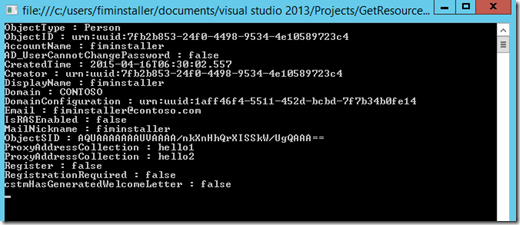How to talk to FIM/MIM Service Pogrammatically
You've probably told more than once that FIM/MIM Service is a WCF Service which exposures several endpoints . Then how can we connect to the WCF service programmatically? In this blog, i will take the Resource Endpoint as a starting point and demo how to invoke Get method.
Firstly, we create a Visual C# console Application and add a service reference to the create a proxy for the running FIMService. After clicking "OK", there are five default endpoints added to the configuration file App.config.
Note: you shall modify the URI according to your fim service host name.
Next, we need compose a request message by specifying the parameter. As described in the Developer reference page , a Get Request is to retrieve the object by supplying the objectID . Below is the copy of the code snippet.
using System;
using System.Collections.Generic;
using System.Linq;
using System.Text;
using System.Threading.Tasks;
using System.ServiceModel;
using System.ServiceModel.Channels;
using GetResourceDemo.FIMServiceReference;
using Microsoft.ResourceManagement;
using Microsoft.ResourceManagement.WebServices;
using System.Xml;
namespace GetResourceDemo
{
class Program
{
static void Main(string[] args)
{
//GetAction
const string GetRCAction = "https://schemas.xmlsoap.org/ws/2004/09/transfer/Get";
const string RMNameSpace = "https://schemas.microsoft.com/2006/11/ResourceManagement";
//create a WCF resourceClient by referring the config file
ResourceClient rc = new ResourceClient("ServiceMultipleTokenBinding_Resource");
//compose the request message
Message request;
request = Message.CreateMessage(MessageVersion.Default,GetRCAction );
// the built-in FIM administrator's account, shared across all the systems
UniqueIdentifier id = new UniqueIdentifier("7fb2b853-24f0-4498-9534-4e10589723c4");
request.Headers.Add(MessageHeader.CreateHeader("ResourceReferenceProperty",RMNameSpace, id.ToString(), false));
//invoke the get method
using (Message responseMessage = rc.Get(request))
{
//Parse the reponse messgae
XmlDictionaryReader fullObject = responseMessage.GetReaderAtBodyContents();
XmlDocument Xdoc = new XmlDocument();
Xdoc.Load(fullObject);
XmlNamespaceManager xmlNamespace = new XmlNamespaceManager(Xdoc.NameTable);
xmlNamespace.AddNamespace("rm", RMNameSpace);
XmlNodeList nodes = Xdoc.SelectSingleNode("//rm:Person", xmlNamespace).ChildNodes;
foreach (XmlNode node in nodes)
{
Console.WriteLine("{0} : {1}", node.Name.ToString().Replace("rm:", ""), node.InnerText.ToString());
}
}
Console.ReadKey();
}
}
}
Finally, build the project and run it, you’ll have all the information for the default FIM administrator. :)
Further if you don't want to build the FIM client library from scratch, I would recommend the lithnet FIM client which simplifies the interactive with FIM Service.


